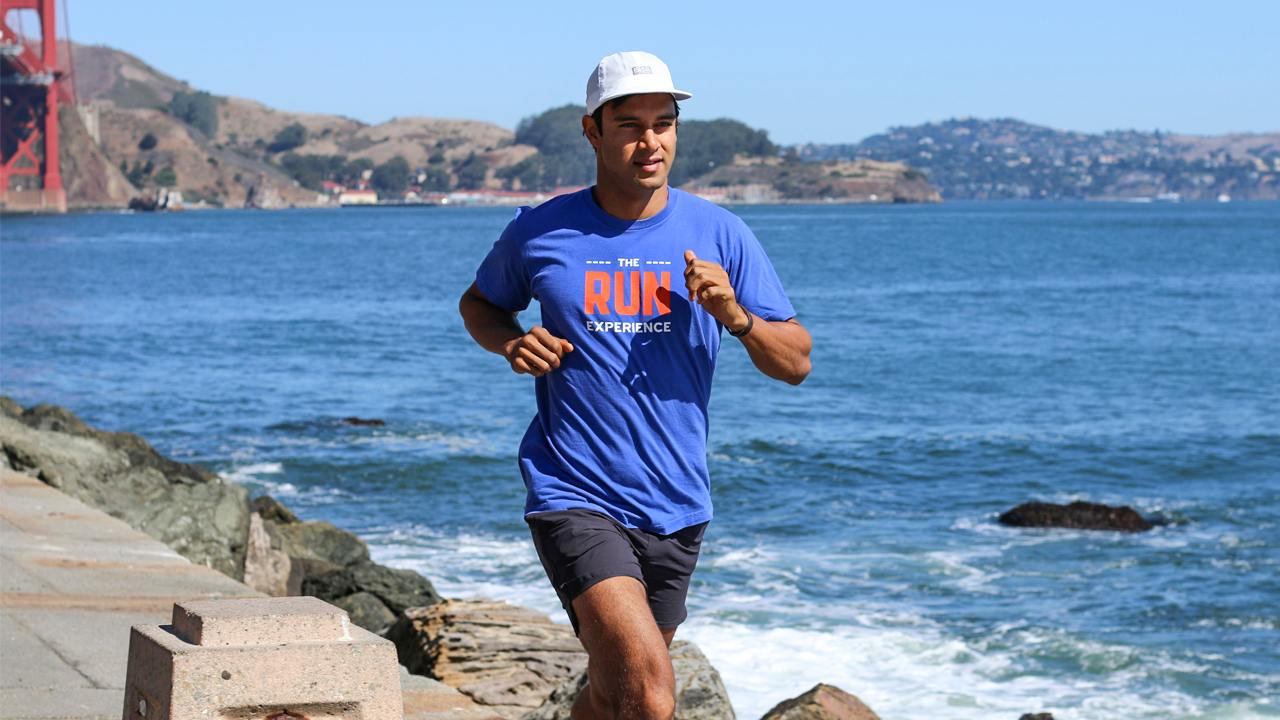10 Tips for Running a Mile Without Stopping (Beginner-Friendly)
Our top tips for running a mile without stopping from start to finish. We cover the best way, time, and preparation to guarantee success!

If you’re a new runner, completing that first mile can seem daunting. We’re here to help. Learn our top tips for running a mile without stopping from start to finish.
Before you know it, you’ll be lacing up your running shoes regularly and getting through a mile easily.
How to Learn to Run a Mile
First, practice makes perfect when you learn how to run a mile. All the study and preparation in the world won’t get you to the finish line when you lace up your shoes.
You’re going to have to get out there, have a good time, and let your body adapt.
The first time you try to run a mile, you might only make it a hundred yards before stopping to catch your breath—and that’s OK. The next time you get out and run, you might make it 200 hundred yards, and then 500 yards.
Running is all about progress and small adaptations. Try to do too much too early, and you risk burnout and overtraining. Your body can’t adapt to these stresses, and your progress will plateau.
How to Prepare for Running a Mile
Preparation is key. First, reading these tips is a great place to start—but there are other things you can do to set the stage for success:
- Study: Learn what it takes to run a mile without stopping. You’re already doing that by reading this post, so you’re on your way to running a mile. Yay!
- Sleep: You’re going to need energy to run a mile and recover from each build-up run, so give your body time to rest.
- Eat: It takes fuel to run. Give your body the nutrients and calories it needs.
- Hydrate: Drink enough water to fuel your run.
- Relax: Don’t stress. Stressing about your mile will tense up your miles and make it harder to recover.
- Commit: Make a plan and commit to action.
- Be Patient: Let it come. Everybody is different and will take different times to adapt. Be patient with your body.
10 Tips for Running a Mile (Beginner-Friendly)
Take it one step at a time. Great runners didn’t get there overnight, so don’t expect to be blazing through a mile after just a day or two. Be patient with yourself, and you’ll be enjoying mile after mile with a little time and effort.
Here are a few of our tried-and-true tips for running a mile.
1. Get the Right Gear
One of my favorite things about running is that it doesn’t require a lot of equipment. You need a good pair of shoes, comfortable socks that wick away sweat, and weather-appropriate clothes. Visit a local running store and talk to an expert who can fit you in shoes that work for you and watch you run in them.
In the winter, wear leggings and light layers you can take off as you warm up. In warmer weather, opt for shorts with a built-in liner for comfort and a light t-shirt or tank top.

2. Warm Up
Don’t plan to just walk out the door and burst into a jog. You need to warm up your muscles to get them ready to move and prevent injury. It doesn’t have to take long–just don’t avoid it. Check out Coach Holly’s video about the right way to warm up for a run.
3. Alternate Walking & Running
If you’ve never run before, it will take a few weeks before you can run a mile without stopping–and that’s ok. Start out by running for a minute and then walking for a minute or two. Listen to your body and see how it feels. Gradually increase the amount of time you run and decrease the amount of time walking as your body feels ready.
How to Run a Mile Without Stopping
That’ll come soon, but don’t push it from the get-go. It takes a bit of training to teach your body how to run a mile without stopping, but when it comes (and it will come), you’ll begin to dramatically increase your endurance.
Don’t be ashamed of the run/walk strategy. Even professionals switch to this form when pushing their weekly volume or training for long-distance events.
Accept the fact that running isn’t just running. Sometimes, it’s just putting one foot in front of the other.
Focus on Consistency
Consistency is more valuable than intensity in the early stages of running. Aim to run regularly, whether it's three times a week or every other day, depending on your schedule and fitness level. Consistent training will help build your aerobic base, strengthen your muscles, and improve your running economy.
Listen to Your Body
Pay attention to how your body responds to training. Some discomfort is normal as you push your physical limits, but sharp pain or persistent issues are signs to ease back and possibly consult a professional. Rest days are as important as training days; they allow your body to recover and grow stronger.
Gradually Increase Distance
Once you start feeling more comfortable running short distances, gradually increase your running segments by a small amount each week—no more than 10% to avoid injury. This gradual increase helps your body adapt safely, reducing the risk of overuse injuries.
Celebrate Small Victories
Every step forward is progress. Celebrating small achievements along your journey to running a mile without stopping is essential for motivation. Whether it's running a bit longer than last time, feeling less out of breath, or simply getting out there when you didn't feel like it, these are all victories worth recognizing.
Mind Over Matter
Finally, cultivate a positive mindset. Running a mile without stopping is as much a mental challenge as it is physical. Encourage yourself, visualize your success, and remember why you started. Running is a journey, and every step brings you closer to your goal.
How Long to Run a Mile Without Stopping?
Good question. It depends.
Your pace and adaptation will determine how long it takes to run a mile without stopping. Your first mile might be at a 12:00-minute pace, but keep it up, and you’ll see your time continue to accelerate.
4. Incorporate Strength Training & Cross-Training
When you’re first starting out, you don’t need to be running every day. You risk burning out, so you need rest days and light activity days. On rest days, you can do a little strength training like yoga or pilates to keep your muscles limber and foster muscle strength. You can also do low impact cross-training like swimming, walking on a treadmill, or cycling on days you don’t run.
5. Discover Your Motivation
As a beginner runner, think about why you want to run in the first place? You might be focused on weight loss or have the ultimate goal to complete a half marathon. Running isn’t easy–especially at first, so keep your end goal at the top of your mind when things get tough. You can even consider getting a running coach to help you develop a training plan, improve your running form and keep you motivated.
6. Keep Your Brain Engaged When Running
Some people don’t like to listen to anything while they run, but I am personally not one of them! I’ve always enjoyed listening to music to help pass the time and keep me motivated on a run. Make a playlist of your favorite songs just for running or search for popular running playlists on an app like Spotify. Some runners also enjoy listening to podcasts while running–it’s up to you!
While you can distract yourself, it’s even better to engage mentally. This is where you focus on what is important to remember when running, like:
- Form
- How you’re feeling
- Cadence
- Distance
- Time
- Motivation
7. Fuel Your Body
Nutrition is a huge part of how good you’ll feel while running. Focus on a balanced diet filled with whole grains, lean protein, healthy fats, fruits, and vegetables. Remember, you don’t have a license to eat whatever you want or carb load because you started exercising, especially if you want to lose weight. Consider using an app like MyFitnessPal to monitor your diet.
8. Find a Running Group
Many beginner runners find it easier to get started running–and stick with it if they have a running buddy or join a running group. Search Facebook groups or Meetups in your community to find a group of new runners. It will also help keep you accountable when you know someone is expecting you to show up for a run!

9. Sign Up For a Running Program
Structure is important. There’s no shortage of running plans you can look up online, but following one designed by experts is helpful. At The Run Experience, we offer We offer flexible programs that you can align with your schedule and fitness level, with guided, follow-along workouts. What are you waiting for? Sign up for a free trial today.
1-Mile Run Trainer
Need help conquering that first mile? We can help. Our coaches and trainers have run-as-you-go programs to coach you from your warmup to your cooldown. We’ll help guide you to finishing that first mile with class, regardless of where you’re starting.
10. Remember to Cool Down
Cooling down after each workout is just as important and warming up beforehand. It doesn’t take a lot of effort, but it helps keep you injury-free and reduces soreness so you’re ready for your next run. Check out Coach Holly’s video about the proper way to cool down.
How to Prepare for a Run?
Preparing for a run involves both physical and mental preparation to ensure you have a comfortable and effective workout. Start by hydrating well throughout the day and consuming a light, carbohydrate-rich snack, such as a banana or a small granola bar, about 30 to 60 minutes before your run to fuel your body. Dress in comfortable, weather-appropriate clothing and good-quality running shoes to avoid discomfort and injuries.
- Warm-up: Begin with a dynamic warm-up consisting of exercises like leg swings, arm circles, and gentle stretching to increase your heart rate and loosen up your muscles.
- Set a Goal: Decide on the distance or duration of your run. Having a clear goal can help keep you focused and motivated.
- Run/Walk Strategy: Especially for beginners, alternating between running and walking can help build endurance without overexertion.
- Listen to Your Body: Pay attention to how you feel during your run. Adjust your pace or take breaks as needed to avoid pushing yourself too hard.
Remember, consistency is key to improvement. Regular runs, coupled with proper preparation and recovery, will enhance your performance and enjoyment of running.
Now Start Running That Mile
Follow these tips for running a mile to get started and working your way towards longer runs—maybe even getting ready for your first 5k. Finally, don’t forget to download our new mobile app for access to expert coaching advice, daily video workouts, injury prevention tips, and complete training programs that will help motivate and inspire your running on a regular basis.
